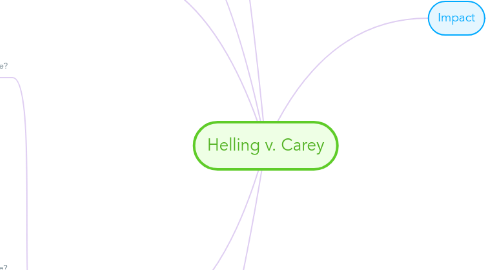
1. Issue
1.1. Whether Dr. Carey and Dr. Laughlin exhibited negligence in their care of Ms. Helling?
2. Rule
2.1. Negligence
2.1.1. Existence of a Duty of Care
2.1.2. Breach of Duty of Care
2.1.2.1. Forseeable risk?
2.1.3. Legal injury
2.1.4. Defendants breach of duty of care directly resulted in the injury
2.1.4.1. Contributory negligence?
3. Application
3.1. Duty of Care?
3.1.1. Ms. Helling began seeing the defendants as a patient in 1959 and regularly saw them until 1968. This clearly establishes that they had a doctor-patient relationship and that the defendants had a duty of care to Ms. Helling.
3.2. Breach of Duty of Care?
3.2.1. The defendants prescribed contact lenses for Ms. Helling and then misdiagnosed her as suffering from irritation from the contact lenses.
3.2.2. They treated her for the wrong condition over a span of 5+ years.
3.2.3. The standard of care for the profession is not to give regular pressure tests to patients until after age 40. There is less than a one percent chance of an individual under 40 developing glaucoma.
3.2.4. A pressure test is easy to administer, does not jeopardize an individual's health in any way, and is relatively cheap to perform.
3.2.5. Despite the small odds, Ms. Helling has the same right to care as individuals over age 40.
3.2.6. Given her many visits and her continued complaints of an issue, the risk of her condition being glaucoma was foreseeable and the defendants failed to act in a prudent manner to give the pressure test earlier.
3.2.6.1. Reasonable prudence requires the defendants to give the pressure test in a timely manner.
3.2.7. The failure to act breached the defendants' duty of care to Ms. Helling.
3.3. Legal Injury?
3.3.1. Ms. Helling developed glaucoma. She lost her peripheral vision and her central vision was significantly reduced. This constitutes a legal injury.
3.4. Defendants' breach of duty of care directly resulted in the injury?
3.4.1. There was no evidence of contributory negligence on the part of Ms. Helling.
3.4.2. Ms. Helling's condition deteriorated over time due to the wrong care being provided and a misdiagnosis.
3.4.3. Therefore, the defendants' breach of duty of care directed resulted in the injury.
4. Conclusion
4.1. Dr. Carey and Dr. Laughlin had a duty of care to Ms. Helling.
4.2. Dr. Carey and Dr. Laughlin breached their duty of care to Ms. Helling.
4.3. Ms. Helling suffered a legal injury.
4.4. Ms. Helling's injury was the direct result of Dr. Carey and Dr. Laughlin's breach of their duty of care.
4.5. Therefore, Dr. Carey and Dr. Laughlin were negligence and should be held liable for Ms. Helling's injury.
5. Facts
5.1. Barbara Helling is suing Dr. Carey and Dr. Laughlin for medical malpractice
5.2. Ms. Helling suffers from primary open angle glaucoma
5.2.1. The disease is difficult to detect unless you take a pressure test.
5.3. Dr. Carey and Dr. Laughlin are ophthalmologists
5.4. Ms. Helling first saw the defendants in 1959 for myopia and nearsightedness. The defendants provided her with contact lenses.
5.5. She next visited them in 1963 due to irritation caused by the contact lenses.
5.6. Ms. Helling consulted the defendants 9 additional times between 1963 and 1968.
5.7. During the 9th visit in 1968, Dr. Carey administered a pressure test, which revealed Ms. Helling had glaucoma at the age of 32.
5.8. Ms. Helling had lost her peripheral vision and her central vision was significantly reduced.
5.9. Ms. Helling sued the defendants claiming negligence resulting in her vision loss.
6. Impact
6.1. Court cases that cite this case
6.1.1. State v. A.N.J. (2010)
6.1.2. Ranger Ins. Co. v. Pierce County (2008)
6.2. Why health professionals care?
6.2.1. Held liable for failing to proactively act even if the standard of care doesn't call for a certain test until a certain age.
6.2.2. Better to order potentially unnecessary tests than take the risk that you are wrong and held liable for a statistically unlikely misdiagnosis.
6.3. Health care practices resulting from the case
6.3.1. Defensive medicine
6.3.2. Evidence-based medicine
